
Sales of smart speakers are expected to nearly double in the US. Google Home Mini, Google Home, Google Home Max. Image: Google
Sales of smart speakers are expected to nearly double in the US, to $3.8 billion, from last year according to Lesley Rohrbaugh and Steve Koenig, researchers with the Consumer Technology Association, which organizes the annual CES trade event.
“That market is not just heating up, it is a wildfire,” Koenig said while discussing industry trends expected to play out at CES and globally in the coming year.
“Compatibility with digital assistants has become table stakes (in the consumer electronics industry).”
Being able to order items, select music, get information, and more by speaking to digital assistants such as Amazon’s Alexa, Google Assistant, and Microsoft’s Cortana has been such a hit that pressure will be on for more ways to interact with machines using voice, the researchers predicted.
At the same time, artificial intelligence will improve, with machines getting better at thinking like people, anticipating desires, and holding conversations instead of simply taking orders, according to Rohrbaugh.
The CES show-floor was expected to be rife with appliances, televisions, vehicles, speakers, robots, and more augmented with virtual assistant software such as Alexa, Cortana, Google Assistant or Samsung’s Bixby.
“We will truly be able to converse with our AI devices,” Rohrbaugh said while envisioning where smart speaker technology was heading.
“AI is going to know you and you will be able to trust the device.”
Behind the scenes, telecommunications service providers around the world will continue to roll-out fifth-generation, or 5G, networks capable of moving seemingly limitless amounts of data blazingly fast, according to the researchers.
Such 5G networks will be key to enabling machines such as self-driving cars to process sensor data quickly enough to make real time decisions, they said.
“Clearly, we don’t want self-driving vehicles to hesitate for even a millisecond, so we are going to need 5G,” Koenig said.
Those higher speeds will also be necessary to “make virtual reality really wireless,” handle data used to manage “smart cities,” power augmented reality, and even to channel the flood of high-definition video streamed online.
“5G and AI are heralds for the coming data age,” Koenig said.
Spending on consumer electronics devices and streaming services in the US alone was expected to climb slightly more than 3 percent this year to $351 billion, with the number of “connected” devices in the country rising to 715 million from 671 million last year. AB
RELATED STORIES:
WATCH: Laundry-folding robot claims it can fold full load of clothes in minutes
HP recalls computer batteries over fire risk
Piece of Chinese solar panel road stolen 5 days after opening